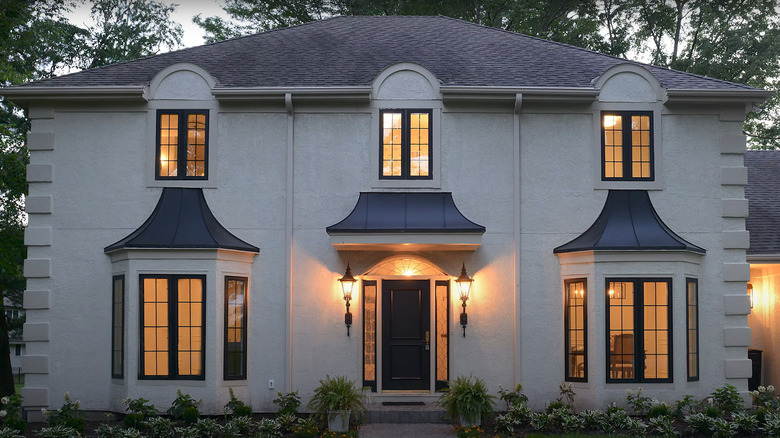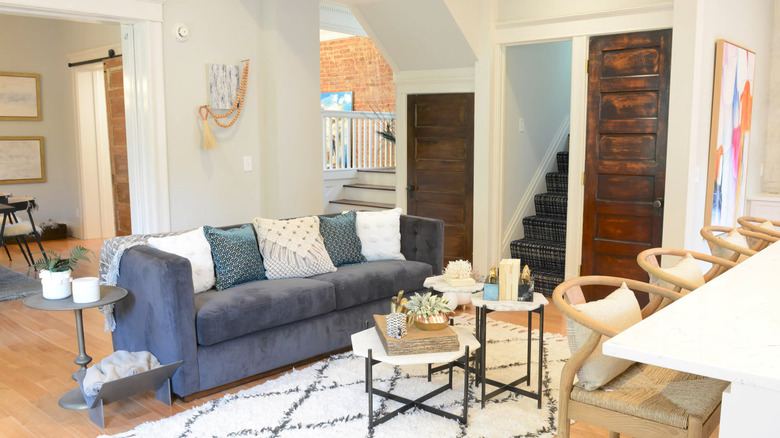What's Wrong With Bargain Mansions, According To An Interior Designer
"Bargain Mansions" follows Tamara Day, a Kansas City home restorer, as she seeks to renovate and revitalize large, neglected homes. The show has run for multiple seasons, but has reportedly raked in some negative comments and criticism throughout its tenure (via IMDb).
"Bargain Mansions" provides a blueprint for some of the things that homeowners and buyers in the market for foreclosures and other properties that need a lot of love arguably shouldn't do. To that end, Insider interviewed a number of interior designers to understand where some home improvement shows shine and other fall flat; when it comes to "Bargain Mansions," the team leans on the expert opinion of Suzan Wemlinger of Suzan J Designs. Wemlinger's most pressing commentary on "Bargain Mansions" (and other popular shows airing on television) revolve around practicality. The problem with "Bargain Mansions" lies in the unrealistic nature of the renovation process, with Wemlinger reporting that this is program is toward the bottom of her list "one of her least favorite shows" as a result.
The reasons for the criticism
Insider's conversation with designer Suzan Wemlinger reveals that the "Bargain Mansions" production excludes all the heavy lifting from filming — or at least the finished product. The show creates unrealistic timelines for people who are seeking these types of programs for inspiration in their own renovations, flipping businesses, or rental properties. This can deflate a homeowner's estimate of required time, energy, and capital that must go into a renovation, setting an investor up for failure before they've even begun.
As well, "Bargain Mansions" doesn't do a good job of showing the teamwork necessary to complete the home renovation process. Even a general contractor requires a stable of professional and knowledgeable hands to aid in the construction process within a home. Yet the program repeatedly underplays the need for external input with Tamara Day working alone on most of her projects aside from the occasional help of her father. Insider reports that this approach to home renovation is completely unrealistic and can easily impart the false understanding that a team of professionals — or at least friends who are willing to make mistakes and learn together — isn't necessary through this labor intensive and time consuming experience.
Lastly, Realtor reports that some of the design elements incorporated into the homes highlighted in the show are actually detrimental to the value of the property being remodeled. In one episode, for instance, Day installs three different tile shapes in a single bathroom.
Other shows for a realistic take on full-scale remodeling
All hope is not lost, however. While it might be tempting to produce a scathing report that highlights all the problems within the home improvement television brand, Insider doesn't do this. Instead, the report leaves readers with a few great television examples of the realistic renovation process.
For one, Insider shared that "This Old House" remains one of the most realistic and influential home improvement shows on television, even after more than 40 years on air. The PBS show follows a design team, hosted by Kevin O'Connor, as they plan and execute a home remodel from start to finish. The final product depicts a realistic budget, timeline, and process that incorporates actual renovation processes, tools and equipment, and a workload that actually makes sense to provide viewers with a more compete picture of what it's really like to renovate a home.
Another highly touted show is "Love It or List It," which follows Hilary Farr and David Visentin (an interior designer and real estate agent, respectively). These personalities compete to sway real life homeowners to either renovate their property or sell it in order to meet the must-haves list of their dream home. Designer Suzan Wemlinger reports that this program does a fantastic job of highlighting the unforeseen complications that can arise during a renovation and provides a realistic understanding of how budgetary constraints and renovation plans can quickly diverge.



